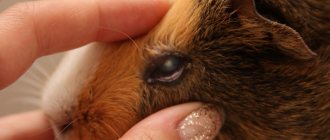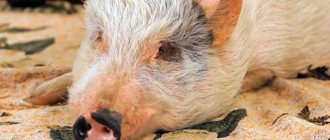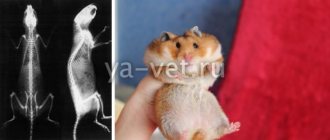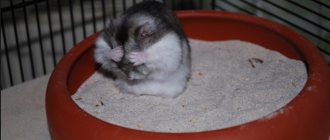Rodents can suffer from various types of diseases. Often their causes are unknown. Unfortunately, according to statistics, every tenth mature hamster has a tumor or neoplasm. It is very disappointing to discover this problem in your pet. But perhaps your pet will be healthy. We recommend that you immediately check your pet, the most vulnerable areas on the body: neck, stomach, paw, back, side, and less often on the butt. These are the ones that need to be checked first. Tumors can be painful or painless, hard or soft.
The most common signs of illness or injury in hamsters
Hamsters usually exhibit one or more of these signs when coping with illness or injury.
loss of appetite inactivity huddling in a corner a disheveled or unkempt coat sneezing, wheezing and/or discharge from the nose or eyes wetness around the tail diarrhea hair loss (often a sign of parasites or allergies)
If your hamster is sick or injured, keep him warm and have him take some food or water (using a dropper if necessary) until the veterinarian arrives.
Eye diseases
Due to their physiological characteristics, Syrian and Djungarian hamsters (as well as representatives of other species) often suffer from ophthalmological pathologies. One of the most common diseases is conjunctivitis (allergic, serous, purulent). Animals are also susceptible to cataracts, glaucoma, and uveitis (inflammation of the choroid).
You can tell if your hamster is sick by the following signs:
- spasmodic closing of the eyelids (spasm of the orbicularis oculi muscle);
- increased lacrimation;
- swelling;
- redness of the eyes;
- mucous or purulent discharge;
- sticking of eyelids.
If such symptoms appear, you should contact a ratologist. It is important to identify the causative agent of the disease (viruses or bacteria) and select appropriate drugs. Typically, eye diseases in hamsters are treated with drops or ointments. Bacteriostatic solutions (Sulfacetamide, Sofradex) and Tetracycline ointment are often used for this purpose.
In advanced cases, the veterinarian will prescribe an antibiotic for the hamster. And vitamin preparations help boost immunity, speed up recovery, and prevent relapse of eye disease. In the initial stages, you can use chamomile decoction or Furacilin solution.
In the absence of timely treatment, the risk of developing a purulent process, visual impairment or complete blindness increases.
Tumors, boils and abscesses
Often, ulcers and neoplasms of a benign or malignant nature are detected in rodents. These could be bumps on the body or a growth in the ear. Pathological formations may appear if the hamster fell from a height, was injured during a fight with relatives, or was attacked by other animals.
To understand the cause of the tumor, you need to show your pet to a veterinarian.
An abscess in a hamster can form from a regular scratch or small wound. After infection penetrates, pus accumulates in the affected area (under the skin). The abscess looks like a swelling that causes pain when pressed. An abscess can form due to prolonged inflammation of the cheek pouches. The disease is treated surgically.
After opening, the cavity is cleaned of pus and washed with antiseptics. The hamster may be prescribed antibiotics.
Often, rodent owners worry about why their hamster has large testicles. More often this phenomenon is normal and indicates readiness for reproduction. But sometimes enlargement of the genital organs is associated with illness:
- the eggs became swollen and their size became more than ¼ of the animal’s body;
- testicles interfere with walking;
- the animal is lethargic, eats poorly, passive;
- the testicles turned red and became hot to the touch;
- the hair on the genitals has completely fallen out;
- hamster tries to gnaw testicles.
If such symptoms appear, you should immediately take your pet to the doctor. Especially if the appearance of alarming signs was preceded by a fall, severe bruise or other injury.
Oncological formations are treated surgically. The sooner the surgery is performed, the greater the chance of a full recovery. If metastases appear, the pet will have to be euthanized. The same should be done if the tumor is localized in a hard-to-reach place, for example in the mouth.
Hamster abscesses
Abscesses are pockets of infection that can form due to minor breaks in the skin. Pus accumulates under the skin, sometimes forming a large lump that sometimes begins to drain on its own.
Abscesses can form from cuts or scrapes in the skin or in the cheek pouches if an abrasive food material causes scratches on the lining of the mouth.
If your hamster constantly looks like he has food in his cheek pouches, this may indicate an abscess or damaged cheek pouch. Abscesses require the attention of a veterinarian for drainage, irrigation, and treatment with antibiotics.
Factors that cause compaction
New growths can be small or huge. According to veterinarians, tumors are more likely to occur in female Djungarian hamsters, which is associated with reproductive characteristics. Males of this species and representatives of other breeds suffer less from this disease.
The reasons that contribute to the appearance of compactions are:
- Fractures or bruises.
- Viral infections.
- Wrong diet.
- The presence of an inflammatory process in the body.
- Congenital pathology.
Depending on the reasons for the appearance of tumors, the types of tumors in hamsters will also be different.
Respiratory infections in hamsters
Hamsters can get respiratory infections that can lead to pneumonia. Signs of a respiratory infection include sneezing, discharge from the eyes or nose, wheezing, and difficulty breathing.
Occasional sneezing is not too concerning, but if there is loss of appetite, decreased activity, wheezing or difficulty breathing, contact your veterinarian immediately.
Warning
Drafts and sudden changes in temperature can put your hamster at risk of developing a respiratory infection, and some types of bedding (such as cedar and pine) can irritate the respiratory tract, which can also lead to infection.
Treatment
To carry out the correct treatment, you need to pay attention to the condition of the tumor. If the area is not very red or swollen, then most likely surgery will not be required. If we are talking only about the inflammatory process, then it is best to prescribe a course of antibiotics or drugs that block tumor growth. If you take the medications on schedule, the abscess will not develop.
If the tumor has become too large, then you need to go to a hospital. In the hospital they must clean the wound and treat it with special compounds. Sometimes it becomes difficult for your pet to move without additional drainage. In such situations, you need to install a special drainage on the baby’s body. It is not possible to make such drainage at home.
If the wound breaks out on its own, then the breakout site should be treated with furatsilin and hydrogen peroxide. Here you don’t have to take your pet to the clinic, but you should definitely consult with a specialist. This is necessary to prevent your pet’s blood from becoming infected. Some infections can be fatal.
Wet tail in hamsters
Wet tail, also called proliferative ileitis and regional enteritis, is a highly contagious disease and most often occurs in recently weaned hamsters. The cause is unclear, but a bacteria called Campylobacter jejuni may be involved, and in some cases the disease is associated with stress, overcrowding and changes in diet.
Affected hamsters can die very quickly, showing signs such as diarrhea (causing wetness around the tail), lethargy, loss of appetite and ruffled fur. Not all hamsters with diarrhea have a wet tail, but if your hamster has any of these symptoms, you should seek help from your veterinarian.
Prevention
Most diseases occur due to unbalanced nutrition and uncomfortable living conditions. You should feed the hamster with ready-made food mixture from the store, adding a little carrots or cauliflower. The animal will happily eat human food - bread or cheese, but such treats most often do harm, undermine the immune system and become the cause of many diseases, including the tumor process. The rodent should not be bathed. He can't stand drafts.
Satiety and fun are the best prevention
Diarrhea in hamsters
A number of infections can cause diarrhea, including but not limited to wet tail, dietary changes, intestinal parasites, and antibiotic treatment. Overfeeding vegetables and other fresh foods is a common cause of diarrhea, but there is usually no loss of appetite or decreased activity.
Dehydration is a serious problem any time your hamster has diarrhea, so make sure he is still drinking water if this happens.
If you have diarrhea, avoid eating fresh foods for a few days and only resume offering them once the diarrhea has completely resolved. Then slowly reintroduce fresh foods so your hamster can slowly adjust to the changes in diet.
If lethargy or lack of water occurs along with diarrhea, you should seek help from your veterinarian.
Treatment and prevention of tumors in hamsters
If the tumor turns out to be benign, then you can resort to preventive procedures. But if the tumor is malignant, surgical intervention is required. Most often this is amputation of limbs. If an inflammatory process has formed on the pet’s body, then treatment consists of taking antibiotics.
In cases where a pet develops oncology in soft tissues, the best way out of the situation is euthanasia. Since such a disease will spread to healthy tissues and, sooner or later, the hamster will die.
To avoid tumors and neoplasms on your pet’s body, you should follow some preventive actions:
- Change the bedding and wash the cage regularly.
- Choose high-quality food for your hamster, without nitrates and preservatives.
- Monitor your pet's emotional state.
- Make sure that toys and accessories have no sharp corners.
- Do not take your pet outside to avoid catching a cold.
- Equip the cage with a wheel or a maze.
Skin diseases in hamsters
Hamsters can be infested with a variety of skin and fur mites, which can be diagnosed by a skin scraping performed by a veterinarian. Ringworm, fungal infection, allergic dermatitis and skin infections can also occur on the skin and require treatment by a veterinarian.
Hair loss is not unusual and may be seasonal or occur in older hamsters. But if the skin develops flaking, redness or any lesions, or if your hamster itches more than usual, you should contact your veterinarian.
Hamsters do have scent glands on their sides, which can be dark and sometimes alarming to owners. They occur on both sides of the body and should not cause irritation or bother the hamster. Cedar bedding can also cause skin irritation and should be avoided.
A tumor is not always oncology
The tumor in hamsters has a different character. What to do if hamsters have a tumor worries many. First of all, tumors can be divided into:
- benign;
- malignant.
Malignant formations on the body of a hamster lead to death. Medicine is still unable to defeat cancer cells. Mutated cells penetrate healthy ones and begin to change their code. This leads to a complete change in DNA, which kills the animal's body.
In addition to all this, the hamster suffers from rabies. Or at least it might hurt. This disease is as dangerous for a hamster as a tumor.
Benign tumors can arise as a result of malfunctions in the diet, injuries or malfunctions of the animal itself. Such tumors are easy to get rid of. They do not grow into the hamster’s body and do not damage neighboring tissues; they are easily removed through surgery.
Sometimes tumors arise due to a hormonal imbalance in the animal. These tumors are more difficult to get rid of.
Swollen paws
If a tumor appears on the paw, your rodent most likely has a closed fracture. To make an accurate diagnosis, it is necessary to take an x-ray. In veterinary practice, treatment of such pathology is based on providing the rodent with complete rest. Plaster application and surgery are not performed in this case.
If a hamster's paw is swollen, it is placed in a separate cage. To prevent further injury to the affected limb, remove the old bedding and make a floor of napkins or toilet paper instead.
Proper nutrition will also be important in order to speed up the healing of the fracture. If the fracture is open and there is suppuration, it is necessary to carry out the procedure of washing the limb with an antiseptic every day.
Sometimes swollen paws in adults are a consequence of cancer. In veterinary medicine this is called osteosarcoma. This disease cannot be cured. It progresses quite quickly, affecting the entire body, as a result of which the hamster dies.
Lumps on the abdomen
Sometimes neoplasms in rodents appear on the abdomen. In most cases, a tumor on the abdomen appears in mature females in the area of the mammary glands and can be either benign or malignant. Since this growth is not internal, it can be removed.
When examining males, it is necessary to remember that their marker glands are located on the abdomen, which are often confused with a sore. In Djungarian hamsters, the gland is yellowish in color and covered with a crust. Syrians have two of them, they are placed in front of the hind legs symmetrically on both sides and resemble an oval black bald spot.
This is not swelling in the hamster’s abdomen, but an anatomical formation and does not need to be treated. But in order to avoid inflammation or neoplasm in the area of the scent gland, an examination is necessary.
Lump on cheek
If an animal has a bump on its cheek that looks like gumboil, this indicates inflammation of the oral cavity, which occurs due to clogging or damage to the cheek pouches with hard, inappropriate food. In the resulting wounds, microbes multiply and provoke severe inflammation, causing swelling on the cheek. The problem is eliminated by visiting a veterinary clinic, where the wounds will be cleaned, disinfected and treated with antibiotics.
If there is a lump on the cheek in the form of a lump under the eye, it is necessary to check the bite, in addition to the cheek pouches. If the teeth are not ground down, malocclusion develops.
Surgical intervention
If a tumor is detected in your pet, you must take a risk and agree to surgical removal. The formations in rodents grow rapidly, the skin cannot withstand it and bursts, forming a fetid, non-healing ulcer. The tumor mass prevents the animal from moving; sometimes the hamsters themselves try to chew off the foreign tissue and die from blood loss. If a limb is affected by cancer, amputation is the best option. If the tumor is on the body, it must be removed while it is still small, otherwise it will be difficult for the surgeon to close the skin defect after removal.
The use of inhalation anesthesia in recent years has increased the survival rate of rodents after surgery. The doctor must have experience working with rodents and ensure that the tiny organism does not become hypothermic during anesthesia. A starvation diet before surgery is not prescribed, and is even harmful.
Removing the tumor itself will not cure the hamster; it will remain sick and may die from tumor metastases to other organs (lungs, liver). But it can improve the quality of life.
If internal organs are affected by cancer, one can only guess about this by the symptoms or asymmetry of the abdomen. In this case, the operation does not make sense and the operation comes down to euthanasia on the surgical table.
Further care
After the autopsy, daily treatment of the wound with antiseptic solutions and ointment is necessary; in addition, experts recommend a course of antibiotic therapy (prescribed by a veterinarian).
You also need:
- taking probiotics – to restore microflora after antibiotics;
- isolation of a sick pet from other animals;
- place a small bottle of warm water in the cage as a heating pad for a small patient;
- temporarily make filler from soft paper or napkins, and clean the home daily;
- The diet of a sick animal must be balanced; it is possible that the animal will drink more than usual; make sure that there is plenty of water.











